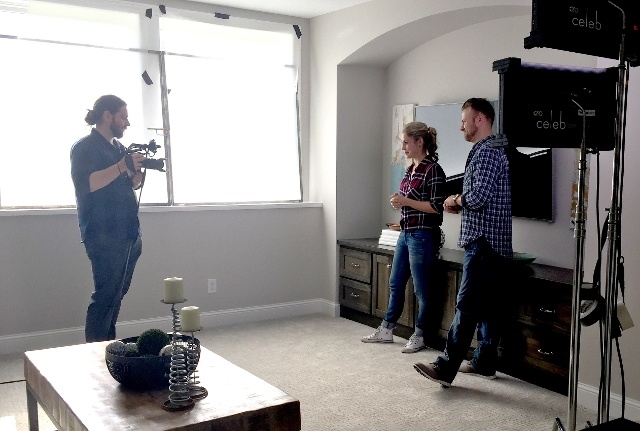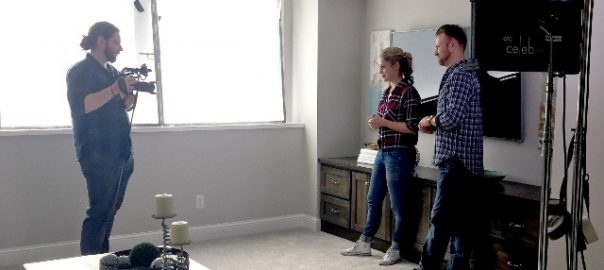— August 23, 2017
Video is everywhere. It’s the shiny (not so new) toy that everyone (and every business) wants to play with. And now they can. Smart phones today can shoot in HD and laptops are even equipped with free, simple video editing software. While smart phone, GoPro, even drone footage is something we all can now explore, should just anyone make a video for your business?
The professionals in the video production industry have been fine-tuning their artistry since long before video exploded into the hands of everyone, and you can tell when it comes down to the final product. Even the untrained eye can spot an amateur video against one that’s been professionally produced. You may not need any help, but here are five ways to tell the difference.
Audio and Visual Quality
As someone who’s been professionally involved in video editing for several years, I find it difficult to watch a video without dissecting all of the things that (in my opinion) could have been better executed. It’s an ingrained tendency to diagnose exactly where the shooter or editor may have fallen short. However, when I watch videos with a non-video friend, commenting on how a shot isn’t “properly white-balanced” means nothing to them. What the average viewer does notice, however, is that something isn’t quite right. They may not know why a particular audio track sounds hollow, but they know that it’s difficult to make out what the subject is saying. Catch my drift?
Amateur video production lacks the proper equipment, the advanced operative training and the years of practical experience that go along with it. A video production team not only has all of the gadgets, more importantly, they know how to work them. Though modern day DSLR cameras can shoot in HD and have vastly improved on-board microphones, they can only get you so far. For a video to look and feel professional, at the very minimum, you will need external microphones, a tripod (with rotation capability, because we aren’t taking still photos) and proper lighting equipment.
External microphones eliminate irreversible ambient noise; lighting equipment highlights your focal point and can improve overall image quality and discoloration; and a tripod will keep your viewers from getting seasick (because even if you think you have a steady grip, an untrained eye can still catch unwanted movement). These are just a few examples of how the proper equipment and training can elevate your final video product from amateur status to professional.
Camera Angles
Another surefire way to spot amateur video production is by its lack of diverse camera shots. I worked in television news for just under five years and spent that time as both a reporter and a multi-media journalist (or MMJ). What’s the difference? Generally, a reporter has a videographer along with them to shoot the video, so that the reporter can just focus on research, interviews and writing. On the other hand, an MMJ is essentially a one-(wo)man-band. They shoot, interview, write, edit — the whole nine yards. Since the station I worked for only had two videographers and roughly eight reporters, I did the MMJ gig more often than not.
Where am I going with this? Well, on the fortunate days where I was given the opportunity to work with a videographer, I was able to get more camera shots for my story (like two-shots of my interactions with the interview subject, which are extremely challenging to set up on your own). This also gave me the opportunity to bring a second camera, maybe a GoPro, to get additional angles while my partner was rolling on something else. The point is, no matter how talented of an MMJ I was, there were inevitable limitations working solo that are comparable to those in amateur video production.
Additionally, a video production team has a trained eye for what’s visually appealing. They know how to frame things up, look for linear patterns, zoom and pan effectively, implement focusing techniques and much, much more. Have you ever watched a video and gone, “Woah! How did they do that?” Well, a professional video team likely has the answer and can make it happen for you, too.
Editing Techniques
Another quick way to determine whether or not a video has been produced professionally is by the quality of the editing. Post production is equally as important as capturing the footage and quality video editing takes a lot of practice. Years of it.
There are a number of complex editing systems to choose from today, each with hundreds of functions and individual nuances. I’ve worked with some for years and still don’t even know them front to back (plus, they’re continually coming out with upgraded versions). While there are many “beginner” editing systems out there today, they lack some of the efficiencies that a more complex editing system can offer — from special effects, graphics, transitions and more.
Plus, professional video editors themselves are trained to know what looks pleasing to the eye; how to arrange shots in a particular sequence; how to eliminate any audio “pops,” how to spot a jump-cuts — the list goes on and on.
Professional Graphics
Let’s say your amateur video is beginning to look a little more polished and now it’s time for the final touches, adding some graphics. Unfortunately, a sloppy graphic can take away from all of your hard work. While you can attempt to MacGyver some basic name titles and information “slides,” video is not a PowerPoint. You’d be missing out on some really great graphic design opportunities.
Check out this video: Why Infographics are Important? A Motion Graphics Video – which is literally just a compilation of eye-catching motion graphics to illustrate their effectiveness and polished look. Can your team whip something together like this? If you don’t have someone who specializes in motion graphics for video, probably not. But chances are a video production company has someone who’s trained to take on such a challenge.
Unnatural scripting
Lastly, the element of amateur video that stands out like a sore thumb. Video expert or not, one thing every viewer can pick-up on is an awkward vibe. Think of the last cheap commercial you watched. It probably contained cringe-worthy scripting that made you feel slightly embarrassed for them.

During my time producing video outside of news, I received countless “bad suggestions” from colleagues from other departments on how to deliver a story line. Even after strongly advising against a doomed vision, some were persistent. So, I made those videos happen (reluctant to put my name on them) and guess what happened? They all tanked. This “gut instinct” is something all video experts have. Through trial and error and much practice, video experts know what works, and even more importantly, what doesn’t. Scripting should feel natural and conversational. Not awkward and forced. They know how to do this the right way.
Whether you’re looking to do a company awareness video or something more business specific, we suggest working with a video production team, rather than trying to whip something together internally if you don’t have the equipment and the expertise. Even if you have someone on your team with very basic video skills and the basic equipment, it’s probably not their specialty. However, it is the sole purpose and forte of a video production team.
Digital & Social Articles on Business 2 Community
(81)






